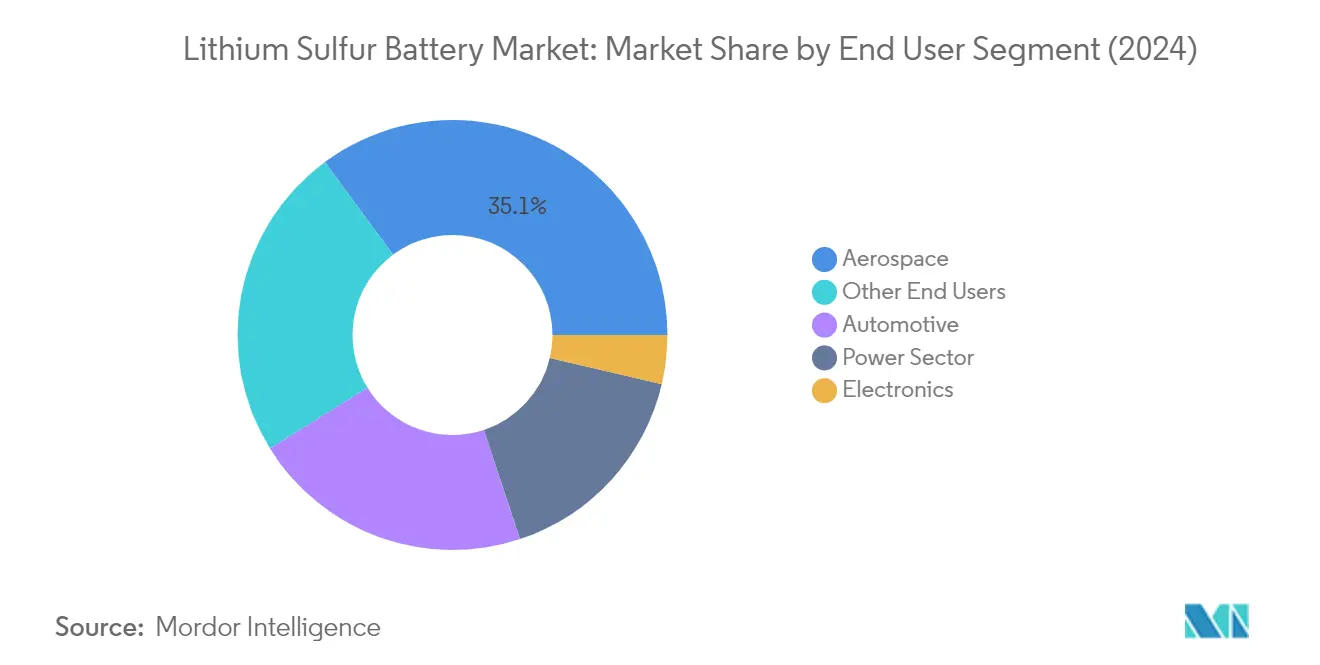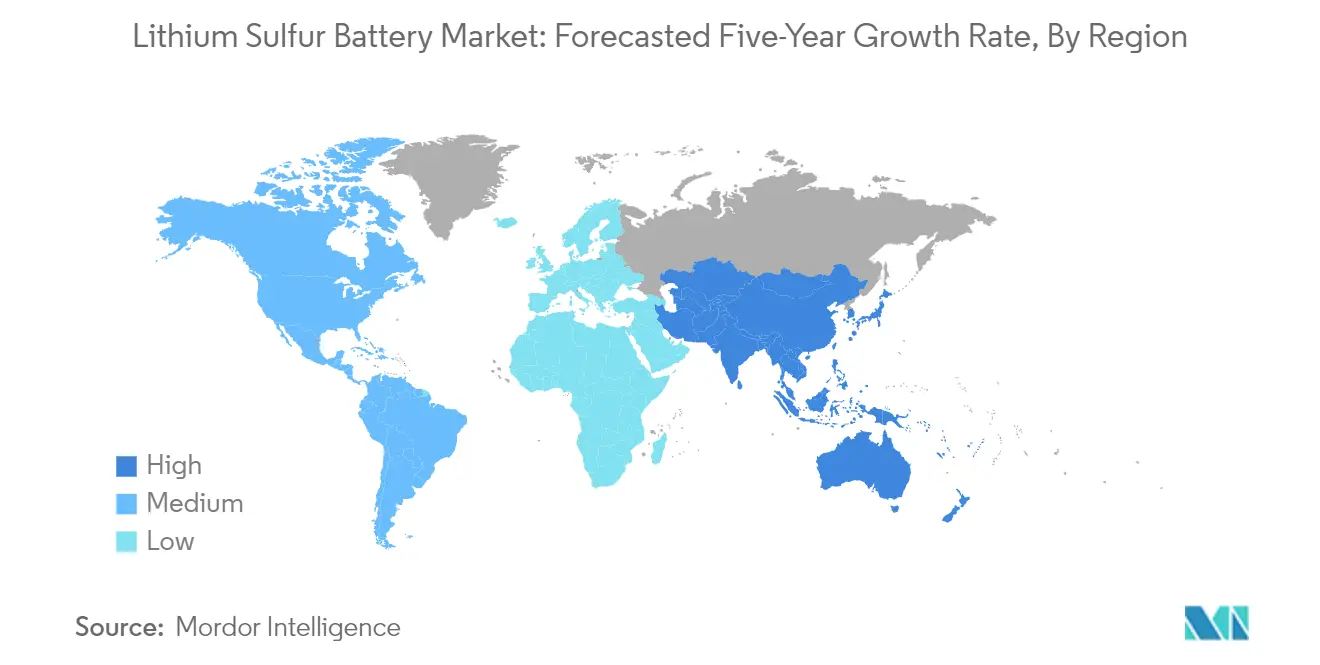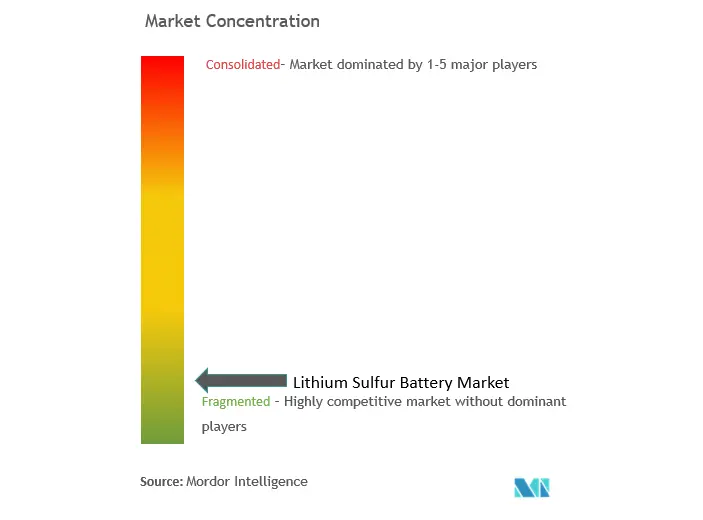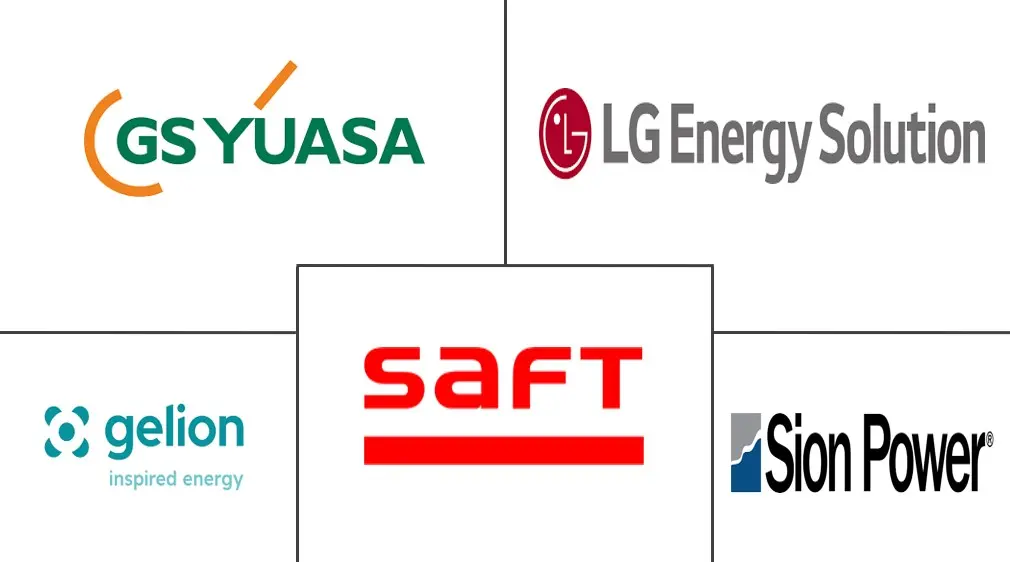Lithium Sulfur Battery Market Size and Share

Lithium Sulfur Battery Market Analysis by Mordor Intelligence
The Lithium Sulfur Battery Market size is estimated at USD 271.44 billion in 2025, and is expected to reach USD 582.52 billion by 2030, at a CAGR of 16.5% during the forecast period (2025-2030).
The lithium-sulfur battery industry is experiencing transformative developments driven by technological innovations and an increasing focus on sustainable battery solutions. The abundance of sulfur as a key raw material provides a significant advantage, with China alone producing approximately 18 million metric tons of sulfur in 2022, making it the world's leading sulfur producer. Recent technological breakthroughs have enhanced the performance capabilities of lithium-sulfur batteries, with companies like American Elements announcing novel electrolyte materials in January 2023, demonstrating the industry's commitment to addressing traditional limitations such as cycle life and stability issues.
The industry is witnessing substantial advancements in battery architecture and design optimization. In May 2023, Li-S Energy achieved a significant milestone by developing a 20-layer battery cell utilizing semi-solid-state lithium-sulfur battery technology, featuring a volumetric energy density of 540 Wh/l and gravimetric energy density exceeding 400 Wh/kg. This development represents a crucial step toward commercialization, as these enhanced specifications surpass traditional lithium batteries in terms of energy density. The integration of innovative materials and manufacturing processes has led to improved battery performance, with companies like StorTera introducing groundbreaking single liquid flow batteries in January 2023, promising extended operational lifespans of up to thirty years.
Manufacturing capabilities are rapidly expanding to meet the anticipated market demand. In June 2023, Lyten commissioned a new lithium-sulfur battery pilot line capable of producing 200,000 cells annually, marking a significant step toward commercial-scale production. The industry is experiencing a shift toward more alternative battery technology and cost-effective manufacturing processes, with lithium-sulfur batteries consuming approximately 90% less energy during production compared to traditional lithium batteries. This manufacturing efficiency, combined with the use of abundant materials, positions lithium-sulfur batteries as a compelling alternative for various applications.
Research and development initiatives are increasingly focusing on addressing the key technical challenges facing lithium-sulfur batteries. Academic institutions and private companies are collaborating to overcome issues related to cycle life, self-discharge, and safety concerns. These collaborative efforts have resulted in significant improvements in battery chemistry and design, with recent innovations focusing on enhanced electrolyte formulations and cathode materials. The industry's commitment to innovation is evident through substantial investments in research and development, with multiple patents being filed for novel manufacturing processes and material compositions, indicating a strong foundation for future technological advancement.
Global Lithium Sulfur Battery Market Trends and Insights
Growing Adoption of Electric Vehicles
The accelerating transition toward electric mobility has emerged as a primary driver for the electric vehicle battery market, with global electric vehicle sales witnessing a remarkable 57% increase between 2021 and 2022. The superior theoretical energy density of lithium-sulfur batteries, which can be up to five times higher than commercial lithium-ion batteries at 2500 Wh/kg, positions them as a promising solution for extending EV driving ranges while reducing battery weight. This technological advantage is particularly significant as automotive manufacturers seek to overcome range anxiety concerns and improve vehicle performance. Various countries have established ambitious electric vehicle targets, with the United States aiming for 50% of all new vehicles to be electric by 2030, while China is targeting a 40% share in the transportation segment via new energy vehicles by 2030.
The increasing government support and policy initiatives worldwide are further accelerating EV adoption and consequently driving interest in lithium-sulfur battery technology. For instance, in June 2023, China unveiled a substantial CNY 520 billion (USD 72.3 billion) tax break package over four years for electric vehicles and other green cars, demonstrating strong governmental commitment to EV adoption. Additionally, major automotive industry investments in lithium-sulfur technology are gaining momentum, as evidenced by Stellantis NV's USD 323.93 million investment in Lyten Inc. in May 2023, aimed at accelerating the commercialization of LytCell™ Lithium-Sulfur EV batteries. The development of lithium-sulfur batteries is particularly attractive for the automotive sector due to their potential to reduce battery costs by two-thirds and consume approximately 90% less energy during production compared to conventional lithium-ion batteries.
Increasing Demand for Energy Storage Systems (ESS)
The growing integration of renewable energy sources into power grids has created substantial demand for advanced energy storage battery solutions, with global renewable energy installed capacity more than doubling from 1,852.77 GW in 2015 to 3,371.79 GW in 2022. Lithium-sulfur batteries are emerging as a promising solution for grid-scale energy storage applications due to their high energy density, cost-effectiveness, and minimal environmental impact. The technology's ability to store and release large amounts of energy efficiently makes it particularly suitable for managing the intermittent nature of renewable energy sources, while the abundance and low cost of sulfur as a key component provide significant economic advantages for large-scale deployment.
Significant technological breakthroughs in 2023 have further strengthened the position of lithium-sulfur batteries in the energy storage market. For instance, StorTera, an Edinburgh-based startup, successfully engineered a groundbreaking lithium-sulfur flow battery boasting an impressive energy density of 250 Wh/L, with the capability to provide up to eight hours of energy storage and a projected operational lifespan exceeding 20 years. The battery system demonstrates remarkable response times in milliseconds and can sustain a minimum of 7,500 charging cycles, making it highly suitable for grid storage battery stabilization and renewable energy integration. These advancements are particularly significant as the renewable energy sector continues to grow, with a notable 10% increase in global renewable capacity between 2021 and 2022, creating increased demand for efficient and cost-effective sustainable energy storage solutions.
Segment Analysis
Aerospace Segment in Lithium Sulfur Battery Market
The aerospace sector dominates the global aerospace battery market, commanding approximately 35% of the market share in 2024. This significant market position is driven by the increasing adoption of aerospace battery technologies in various aerospace applications, including satellites, high-altitude aircraft, outer space vehicles, and unmanned aerial vehicles (UAVs). The sector's dominance is particularly evident in High Altitude Platform Station (HAPS) and High Altitude Long Endurance (HALE) aircraft applications, where the high energy density and lightweight characteristics of lithium-sulfur batteries provide crucial advantages. Major developments in 2023, such as NASA's Technology Transfer Program seeking partners for lithium-sulfur battery designs and South Dakota Mines receiving a $750,000 NASA EPSCoR grant for next-generation lithium-sulfur battery research, further solidify the aerospace sector's leading position in the drone battery market.

Automotive Segment in Lithium Sulfur Battery Market
The automotive sector represents the fastest-growing segment in the lithium sulfur battery market, with substantial growth projected between 2024 and 2029. This remarkable growth trajectory is primarily driven by the increasing global push toward electric vehicle adoption and the advantages that EV battery technologies offer, including higher energy density and potential for longer driving ranges. The segment's growth is supported by significant industry developments, such as Stellantis NV's $323.93 million investment in Lyten Inc. in 2023 for commercializing LytCell™ electric vehicle battery technologies. Additionally, German start-up Theion GmbH's progress in developing lithium-sulfur batteries with fast charging capabilities and potential cost reductions of up to two-thirds compared to conventional batteries demonstrates the segment's innovative momentum.
Remaining Segments in Lithium Sulfur Battery Market by End User
The electronics, power sector, and other end-user segments, including aviation and maritime applications, constitute significant portions of the lithium sulfur battery market. The electronics segment focuses on applications in smartphones, cameras, laptops, and tablets, benefiting from the lower manufacturing costs and higher energy density of lithium-sulfur batteries. The power sector segment is driven by the increasing demand for energy storage systems and grid stability applications, particularly in renewable energy integration. The other end-users segment, encompassing aviation and maritime applications, shows promise in specialized applications such as autonomous underwater vehicles (AUVs) and advanced maritime operations, where the batteries' high energy density and pressure tolerance capabilities provide distinct advantages.
Geography Analysis
Lithium-Sulfur Battery Market in North America
The North American lithium-sulfur battery market encompasses significant developments across the United States, Canada, and other countries in the region. The market is characterized by extensive research and development activities, particularly in advancing battery technologies for aerospace, electric vehicles, and energy storage applications. The region benefits from strong government support through policies and funding initiatives aimed at promoting sustainable energy solutions. The presence of key market players and research institutions, combined with growing investments in battery technology development, positions North America as a crucial market for lithium-sulfur batteries.

Lithium-Sulfur Battery Market in the United States
The United States leads the North American market with approximately 45% market share in 2024. The country's dominance is driven by substantial investments in research and development of alternative energy storage battery markets. Various research institutions, universities, and companies are actively engaged in lithium-sulfur battery development, focusing on addressing challenges such as cycle life, self-discharge, and safety. The country has witnessed significant progress in pilot production facilities, with companies like Lyten commissioning facilities capable of producing lithium-sulfur cells for early-adopting customers within the automotive, defense, satellite, and logistics sectors.
Lithium-Sulfur Battery Market in Canada
Canada emerges as the fastest-growing market in North America, with an expected growth rate of approximately 6% during 2024-2029. The country's growth is primarily attributed to its rich natural resources and increasing focus on developing sustainable energy storage solutions. Canada's strategic advantage lies in its ability to source materials domestically for lithium-sulfur battery production, reducing dependency on imports. The country's commitment to electric vehicle adoption and renewable energy integration, particularly in provinces like Ontario, creates substantial opportunities for lithium battery market deployment.
Lithium-Sulfur Battery Market in Europe
The European lithium-sulfur battery market demonstrates strong potential across Germany, France, the United Kingdom, and other European nations. The region's market is driven by aggressive environmental policies, substantial investments in renewable energy, and a robust automotive sector transitioning towards electrification. European countries have established comprehensive frameworks to support battery technology development, with various research institutions and companies actively working on advancing lithium-sulfur battery technology.
Lithium-Sulfur Battery Market in Germany
Germany maintains its position as the largest market in Europe, commanding approximately 35% of the regional market share in 2024. The country's leadership is supported by its strong automotive industry, significant investments in battery research, and development initiatives. German research organizations like Fraunhofer have made substantial progress in improving lithium-sulfur cell performance and technical characteristics. The country's commitment to electric mobility and energy storage solutions continues to drive innovation in lithium battery market technology.
Lithium-Sulfur Battery Market in the United Kingdom
The United Kingdom demonstrates the highest growth potential in Europe, with an anticipated growth rate of approximately 7% from 2024-2029. The country's growth is fueled by significant investments in lithium-sulfur battery research and development, particularly through initiatives like the Faraday Institution's Lithium-Sulfur Technology Accelerator (LiSTAR) project. British companies and research institutions are at the forefront of developing innovative solutions to enhance battery performance and durability, positioning the UK as a key player in the European lithium battery market size.
Lithium-Sulfur Battery Market in Asia-Pacific
The Asia-Pacific lithium-sulfur battery market encompasses major economies including China, India, Japan, and South Korea. The region demonstrates strong potential for market growth, supported by extensive manufacturing capabilities, technological advancement, and increasing demand for sustainable energy storage solutions. Government initiatives promoting electric vehicle adoption and renewable energy integration across various countries contribute to market expansion.
Lithium-Sulfur Battery Market in China
China maintains its position as the dominant force in the Asia-Pacific lithium-sulfur battery market. The country's leadership is attributed to its robust manufacturing infrastructure, significant investments in research and development, and strong government support for new battery technologies. Chinese research institutions and companies have achieved notable breakthroughs in enhancing lithium-sulfur battery performance, particularly in addressing challenges related to cycle life and stability.
Lithium-Sulfur Battery Market in India
India emerges as the fastest-growing market in the Asia-Pacific region. The country's growth is driven by increasing investments in battery technology research, growing demand for electric vehicles, and government initiatives supporting domestic battery production. Indian research institutions and companies are actively working on developing cost-effective and efficient lithium-sulfur battery solutions, particularly focusing on applications in electric mobility and renewable energy storage, contributing to the regional EV battery market.
Lithium-Sulfur Battery Market in South America
The South American lithium-sulfur battery market, comprising Brazil, Argentina, and other countries, shows promising development potential. The region benefits from abundant natural resources, particularly lithium reserves, which provide a strategic advantage for battery production. Brazil emerges as both the largest and fastest-growing market in the region, supported by its developing electric vehicle industry and increasing focus on renewable energy integration. Argentina's significant lithium resources and growing focus on battery technology development also contribute to regional market growth.
Lithium-Sulfur Battery Market in the Middle East & Africa
The Middle East & Africa market, encompassing Saudi Arabia, United Arab Emirates, South Africa, and other nations, demonstrates increasing interest in lithium-sulfur battery technology. The region's market development is driven by growing investments in renewable energy projects and increasing focus on diversifying energy sources. Saudi Arabia represents the largest market in the region, while the United Arab Emirates shows the fastest growth potential, supported by its ambitious clean energy initiatives and technological advancement programs, contributing to the regional battery market.
Competitive Landscape
Top Companies in Lithium Sulfur Battery Market
The lithium sulfur battery companies market is characterized by a mix of established energy storage companies and innovative startups driving technological advancement. Companies are heavily investing in research and development to overcome technical challenges like cycle life limitations and improve overall battery performance. Strategic collaborations between battery manufacturers and automotive companies are becoming increasingly common to accelerate commercialization efforts. Major players are focusing on vertical integration to secure raw material supply chains and optimize production costs. The industry is witnessing significant patent activity and intellectual property development, particularly in electrode materials and cell design. Manufacturing facilities are being expanded globally to meet the anticipated demand from electric vehicles and energy storage applications. Companies are also emphasizing sustainable production methods and recycling capabilities to align with environmental regulations and market preferences.
Dynamic Market Structure with Growing Consolidation
The lithium sulfur battery market exhibits a relatively concentrated structure dominated by established battery manufacturers and energy technology conglomerates, particularly from Asia and North America. These major players leverage their extensive research capabilities, manufacturing infrastructure, and established customer relationships to maintain market leadership. The industry is witnessing increased participation from specialized technology firms focusing exclusively on lithium sulfur battery development, bringing innovative solutions and specialized expertise. Market consolidation is primarily driven by strategic acquisitions of smaller technology companies by larger corporations seeking to enhance their technical capabilities and intellectual property portfolios.
The market is characterized by significant barriers to entry due to high capital requirements, technical expertise needs, and extensive regulatory compliance requirements. Merger and acquisition activities are predominantly focused on securing advanced technology patents and expanding geographical presence. Joint ventures and strategic partnerships between battery manufacturers and end-user industries, particularly the automotive and aerospace sectors, are becoming increasingly common. Regional players are expanding their presence through licensing agreements and technology transfer partnerships with global leaders while maintaining strong local market positions.
Innovation and Partnerships Drive Future Success
Success in the lithium sulfur battery market increasingly depends on technological innovation capabilities and strategic partnership development. Companies must focus on improving battery performance metrics, particularly energy density and cycle life, while simultaneously reducing production costs through process optimization and economies of scale. The ability to secure long-term supply agreements with key raw material providers and establish strong relationships with end-users in high-growth sectors like electric vehicles and aerospace is crucial. Regulatory compliance and environmental sustainability considerations are becoming increasingly important factors in determining market success.
For new entrants and smaller players, specialization in specific applications or components of the lithium sulfur battery value chain offers opportunities for market penetration. Success factors include developing proprietary technologies that address specific market needs, forming strategic alliances with established players for manufacturing and distribution, and maintaining flexibility to adapt to rapidly evolving market requirements. The concentration of end-users in specific sectors like automotive and aerospace necessitates strong industry relationships and customized product development capabilities. Companies must also consider potential substitution risks from competing battery technologies and maintain robust research and development programs to stay competitive. The lithium battery industry and rechargeable battery industry are both crucial in shaping the future of energy storage solutions, with ongoing advancements and partnerships driving the sector forward.
Lithium Sulfur Battery Industry Leaders
-
GS Yuasa Corporation
-
LG Energy Solutions Ltd.
-
Saft Groupe SA
-
Gelion PLC
-
Sion Power Corporation
- *Disclaimer: Major Players sorted in no particular order

Recent Industry Developments
- June 2023: Lyten Inc., a United States-based battery manufacturer, announced the commissioning of its lithium-sulfur battery pilot line in Silicon Valley. The lithium-sulfur pilot line is expected to start delivering commercial battery cells by the end of 2023 to early adopting customers within the defense, logistics, automotive, and satellite sectors.
- May 2023: the Australian battery technology company Li-S Energy announced the development of 20-layer battery cells utilizing third-generation semi-solid-state lithium-sulfur battery technology. Compared to current lithium-ion (Li-ion) cells, this performance is nearly double the gravimetric energy density and a comparable volumetric energy density.
Global Lithium Sulfur Battery Market Report Scope
Lithium-sulfur battery (Li-S) is a type of rechargeable battery that utilizes sulfur as the cathode and lithium as the anode. In a lithium-sulfur battery, during discharge, lithium ions from the anode react with sulfur at the cathode, forming lithium sulfide and releasing electrons.
The lithium-sulfur battery market is segmented by end user and geography. By end user, the market is segmented into aerospace, electronics, automotive, power sector, and other end users. The report also covers the size and forecasts for the lithium-sulfur battery market across major regions. The market sizing and forecasts are based on revenue (USD) for each segment.
| Aerospace |
| Electronics |
| Automotive |
| Power Sector |
| Other End Users |
| North America | United States |
| Canada | |
| Rest of North America | |
| Europe | Germany |
| France | |
| United Kingdom | |
| Rest of Europe | |
| Asia-Pacific | China |
| India | |
| Japan | |
| South Korea | |
| Rest of Asia-Pacific | |
| South America | Brazil |
| Argentina | |
| Rest of South America | |
| Middle East and Africa | Saudi Arabia |
| United Arab Emirates | |
| South Africa | |
| Rest of Middle East and Africa |
| End User | Aerospace | |
| Electronics | ||
| Automotive | ||
| Power Sector | ||
| Other End Users | ||
| Geography | North America | United States |
| Canada | ||
| Rest of North America | ||
| Europe | Germany | |
| France | ||
| United Kingdom | ||
| Rest of Europe | ||
| Asia-Pacific | China | |
| India | ||
| Japan | ||
| South Korea | ||
| Rest of Asia-Pacific | ||
| South America | Brazil | |
| Argentina | ||
| Rest of South America | ||
| Middle East and Africa | Saudi Arabia | |
| United Arab Emirates | ||
| South Africa | ||
| Rest of Middle East and Africa | ||
Key Questions Answered in the Report
How big is the Lithium Sulfur Battery Market?
The Lithium Sulfur Battery Market size is expected to reach USD 271.44 billion in 2025 and grow at a CAGR of 16.5% to reach USD 582.52 billion by 2030.
What is the current Lithium Sulfur Battery Market size?
In 2025, the Lithium Sulfur Battery Market size is expected to reach USD 271.44 billion.
Who are the key players in Lithium Sulfur Battery Market?
GS Yuasa Corporation, LG Energy Solutions Ltd., Saft Groupe SA, Gelion PLC and Sion Power Corporation are the major companies operating in the Lithium Sulfur Battery Market.
Which is the fastest growing region in Lithium Sulfur Battery Market?
Asia Pacific is estimated to grow at the highest CAGR over the forecast period (2025-2030).
Which region has the biggest share in Lithium Sulfur Battery Market?
In 2025, the Asia Pacific accounts for the largest market share in Lithium Sulfur Battery Market.
What years does this Lithium Sulfur Battery Market cover, and what was the market size in 2024?
In 2024, the Lithium Sulfur Battery Market size was estimated at USD 226.65 billion. The report covers the Lithium Sulfur Battery Market historical market size for years: 2020, 2021, 2022, 2023 and 2024. The report also forecasts the Lithium Sulfur Battery Market size for years: 2025, 2026, 2027, 2028, 2029 and 2030.
Page last updated on:



